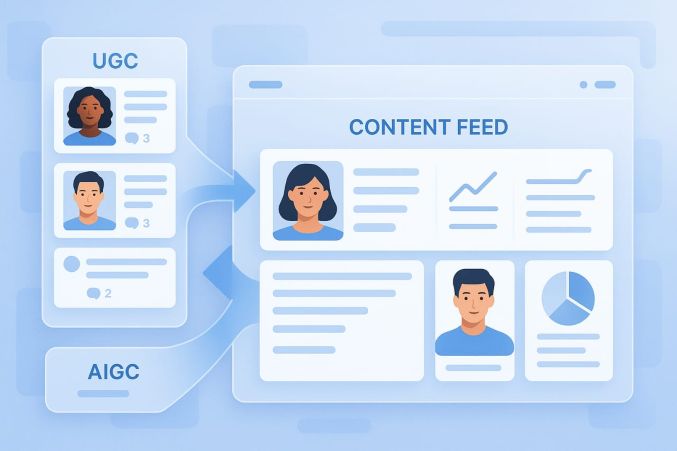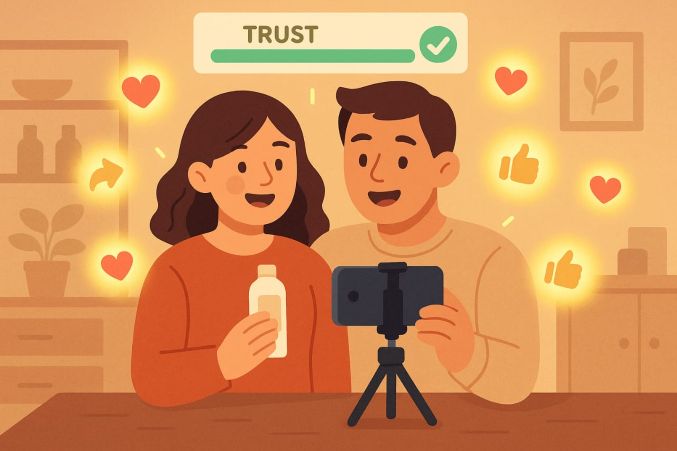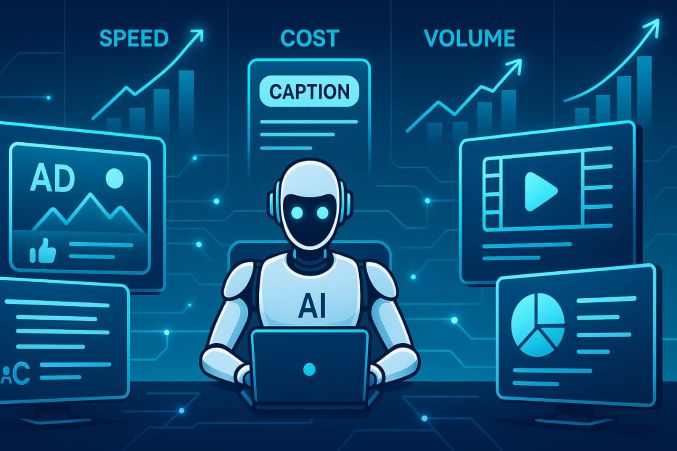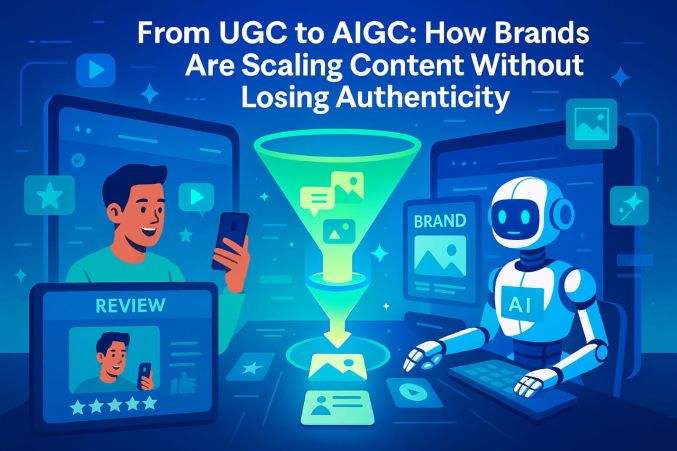From UGC to AIGC: The Ways in Which Brands Are Scaling Content without Sacrificing Authenticity
With the fast-paced nature of today's digital world, brands are always on the spot to create high-quality, compelling content at scale. Two strategies have proven to be game-changers: User-Generated Content (UGC) and AI-Generated Content (AIGC). While UGC has been the gold standard of authenticity for years, AIGC is now making it possible for brands to produce content at scale like never before.
But how can businesses leverage both without sacrificing trust and relatability? In this blog, we’ll explore the differences between UGC and AIGC, why brands are adopting AI-generated content, and how to maintain authenticity in an AI-driven content world.

1. UGC vs. AIGC: What’s the Difference and Why It Matters in 2025
Defining UGC and AIGC
- User-Generated Content (UGC): Any material—photos, videos, reviews, testimonials—produced by actual customers instead of brands. Examples: customer Instagram posts, TikTok reviews, and Reddit discussions.
- AI-Generated Content (AIGC): Content produced by artificial intelligence, including text (ChatGPT, Jasper), images (MidJourney, DALL·E), and even video (Synthesia, Runway).
Why the Distinction Matters
- Trust vs. Scalability: UGC is naturally trustworthy because it comes from actual humans, whereas AIGC provides speed and quantity.
- 2025 Consumer Expectations: While AI-generated content is becoming more common, people are getting smarter at recognizing machine-generated writing. Brands should balance automation with human insight.
- Algorithm Faves & SEO: Search engines and social media platforms increasingly favor authentic engagement, so AI-generated content alone could fall short unless properly optimized.
Brands that recognize the values of both UGC and AIGC will reign supreme with content strategy in 2025.
2. The Rise of AI-Generated Content: Why Brands Are Adopting AIGC
AI-generated content is going through the roof, and it's easy to see why. Here's how brands are jumping at it:
1. Unparalleled Scalability
- HUNDREDS of blog drafts, ad copies, or social posts can be created by AI in minutes, which is simply not possible with human-only teams.
- Illustration: E-commerce businesses leverage AI to auto-generate product descriptions for thousands of SKUs.
2. Speed & Efficiency
- Real-time generation of content for trending topics, social media replies, and individualized marketing.
- Example: Media agencies employ AI to generate breaking news summaries in seconds.
3. Cost-Effectiveness
- Minimizes reliance on large content teams, freelancers, and agencies.
- Example: Small businesses employ ChatGPT to write emails and social captions rather than hiring copywriters.
But excessive use of AIGC can make brands sound mechanized. The trick is to marry AI efficiency with human imagination.

3. The Force of Authenticity: Why UGC Still Dominates in Trust-Building
Despite the advancements in AI, UGC is still the most trusted content. Here's why:
1. Social Proof & Credibility
- 92% of customers rely on peer recommendations ahead of branded advertising (Nielsen).
- Example: Airbnb depends greatly on genuine guest images and reviews.
2. Emotional Connection
- Genuine stories from genuine people build stronger engagement.
- Example: GoPro's UGC-based marketing features exhilarating customer experiences.
3. Community Building
- Encouraging UGC builds a loyal brand community.
- Example: Starbucks' #RedCupContest converts customers into brand fans.
Takeaway: While AIGC is fantastic for scale, UGC is still irreplaceable for trust and engagement.
4. Hybrid Content Strategies: Blending UGC and AIGC for Maximum Impact
The best brands don't decide between UGC and AIGC—they combine them.
Effective Hybrid Strategies:
- AI-Powered UGC Curation: Leverage AI to spot and repurpose high-performing UGC (e.g., TikTok comments converted into ad scripts).
- AI Drafts + Human Polish: Create AI initial drafts, then humanize them.
- Personalized AIGC + UGC Social Proof: AI creates customized emails, while UGC reviews increase conversions.
Example: Glossier utilizes UGC for real beauty reviews but uses AI for interactive ad copy versions.
5. AIGC Without the "Fake" Feel: How to Keep Content Relatable
AI content can come across as artificial. Here's how to make it more relatable:
1. Adopt a Conversational Tone
- Steer clear of robotic speech—contractions, humor, and slang are acceptable where relevant.
- Example: Duolingo's TikTok has AI-supported scripts but maintains them quirky and fun.
2. Integrate Real Data & UGC
- Integrate AI-created insights with real customer testimonials.
- Example: An AI-created blog post can have real users' embedded tweets.
3. Platform-Native Optimization
- Tone down for every platform (quipsy for TikTok, formal for LinkedIn).
- Example: Wendy's employs AI-supported snarky tweets but maintains them platform-specific.
Pro Tip: Always have a human read AI content prior to publishing to verify relatability.
6. Tools & Platforms Driving AIGC Content at Scale
Content tools powered by AI are coming a long way, enabling brands to create text, images, and even videos in mere seconds. These are the leading platforms marketers are leveraging in 2025:
AI Writing Assistants
- Jasper – Most suitable for long-form blog posts, ad copy, and SEO content.
- Copy.ai – Ideal for snapping social media copy, email copy, and brainstorming.
- ChatGPT (OpenAI) – A do-it-all tool for everything from customer service answers to creative writing.
- Canva Magic Write – Automatically creates design-friendly text for social posts, presentations, and more.
AI Image & Video Generators
- MidJourney & DALL·E 3 – Design amazing visuals for ads, blogs, and social media.
- Runway ML – Artificial intelligence video editing and creation for dynamic marketing content.
- Synthesia – Create AI-spokesperson videos without the need for actors.
AI Content Optimization Tools
- SurferSEO – Improves AI-drafted versions with SEO suggestions in real-time.
- GrammarlyGO – Refines AI content for tone, clarity, and brand voice.
Real-World Example:
- eBay utilizes AI tools such as Jasper to automatically generate product descriptions, which are then manually edited to have a natural tone.
Pro Tip: Do not completely trust AI—utilize these tools as a first draft, and then edit with human ingenuity.

7. Creator Partnerships + AIGC: The Recipe for Content Speed
Consumers are increasingly pairing with creators to preserve authenticity while tapping AI for scale. That's how it plays out:
1. AI-Generated Scripts + Creator Personality
- AI writes video scripts, and influencers provide their own touch.
- Example: A beauty brand uses ChatGPT to script a "morning routine" video, but the creator improvises narration for authenticity.
2. AI-Assisted Editing for Accelerated Workflow
- Editing tools such as Descript and CapCut AI enable creators to edit videos quicker, thus more content in a shorter time.
3. Hyper-Personalized Collaborations
- AI digs into audience data to recommend content ideas specific to a creator's fans.
- Example: A fitness company uses AI to find trending workout questions, then collaborates with trainers to record answers.
Why It Works:
- Speed: AI speeds up ideation and production.
- Authenticity: Creators maintain the content authentic and interactive.
8. AIGC Brand Guidelines: Voice, Tone, and Ethics
AI sounds robotic—or worse, off-brand—if left unguided. Here's how to keep AIGC in-message and ethical:
Establish Your Brand's AI Style Guide
- Tone: Should it sound professional, playful, or conversational?
- Word Blacklist: Steer clear of jargon or words that don't fit your brand.
- Ethical Boundaries: Never leverage AI to spread disinformation or synthetic reviews.
Be Transparent About AI Use When Needed
- Google and the FTC now demand disclosure when AI creates misleading content (such as fake reviews).
- Best Practice: Include a statement such as, "This post was generated with AI help."
Human Oversight Is Non-Negotiable
- Personally have a team member review AI content before publishing.
- Example: The Washington Post leverages AI for election news but has reporters fact-check each one.

9. Measuring the Impact: Engagement Metrics for UGC vs. AIGC
How can you tell if your hybrid approach is successful? Monitor these most important metrics:
|
Metric |
UGC Works Better On |
AIGC Works Better On |
|
Engagement Rate |
Higher (feels more personal) |
Good for scalable content |
|
Conversion Rate |
Stronger trust = more sales |
Works well for retargeting ads |
|
SEO Performance |
Earns backlinks naturally |
Great for keyword-dense blogs |
|
Cost Efficiency |
Requires incentivizing users |
Cheaper at scale |
Case Study:
- Sephora's #SephoraSquad UGC promotion generated a 10% sales uplift, while their AI-driven product descriptions boosted SEO traffic by 30%.
Takeaway: Leverage UGC for trust and AIGC for scalable reach, then measure both to maximize.
10. What's Next: The Future of Content Creation in an AI-First Era
The AI content revolution has just started. Here's what is next in the next couple of years:
Voice & Audio AIGC Will Boom
- AI-created podcasts, voice-overs, and even customized radio commercials are on the rise.
- Example: Spotify's AI DJ creates playlists using a synthetic but natural-sounding voice.
Deepfake Moderation Will Be Crucial
- Brands must combat AI-generated impersonations and fraud.
- Solution: Blockchain-verified content and AI-detection tools (like OpenAI’s detector).
Hyper-Personalized Content at Scale
- AI will craft 1:1 dynamic content based on user behavior.
- Example: Netflix already uses AI to personalize thumbnails—soon, entire trailers could be AI-generated per viewer.
AI + Human Collaboration Will Be the Standard
- The best content will come from AI speed + human creativity.
- Example: AI is employed by newsrooms in data-intensive stories but journalists are used for analysis.
Last Thoughts: The Balance of Scale & Authenticity
AI is revolutionizing content creation, yet human touch remains supreme. The brands that succeed will:
✔ Leverage AI for effectiveness—but not as a full substitute.
✔ Amplify UGC to maintain trust and community.
✔ Be open about AI usage to uphold credibility.
What’s your brand’s approach? Are you all-in on AI, sticking with UGC, or blending both? Let’s discuss in the comments!


Comments
Alfishan Sam
Alfishan Sam
Alfishan Sam
Alfishan Sam
Alfishan Sam
Alfishan Sam
Alfishan Sam
Alfishan Sam